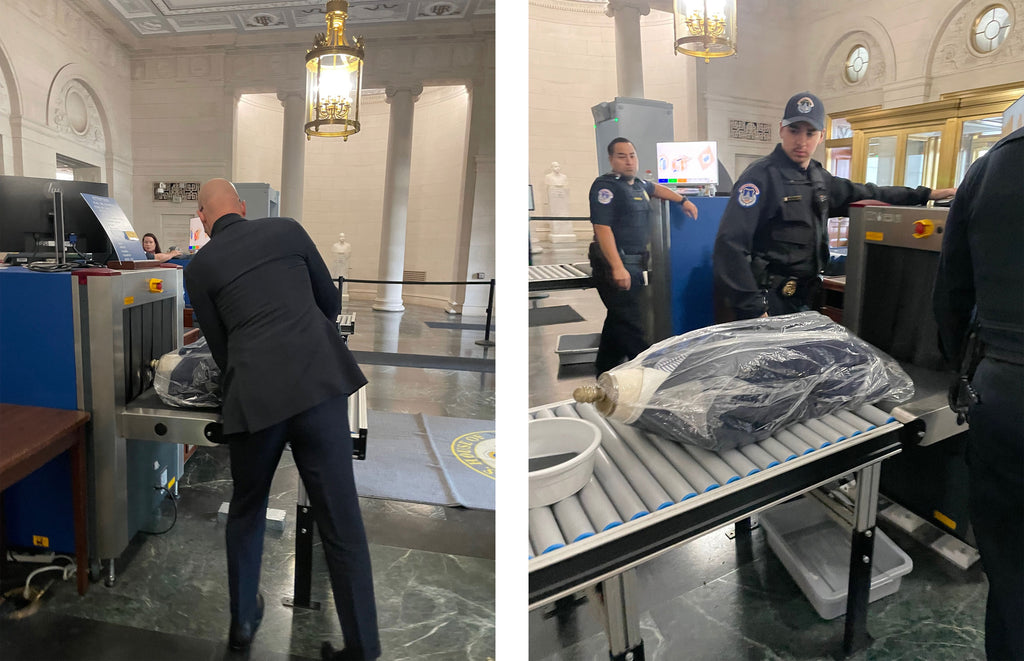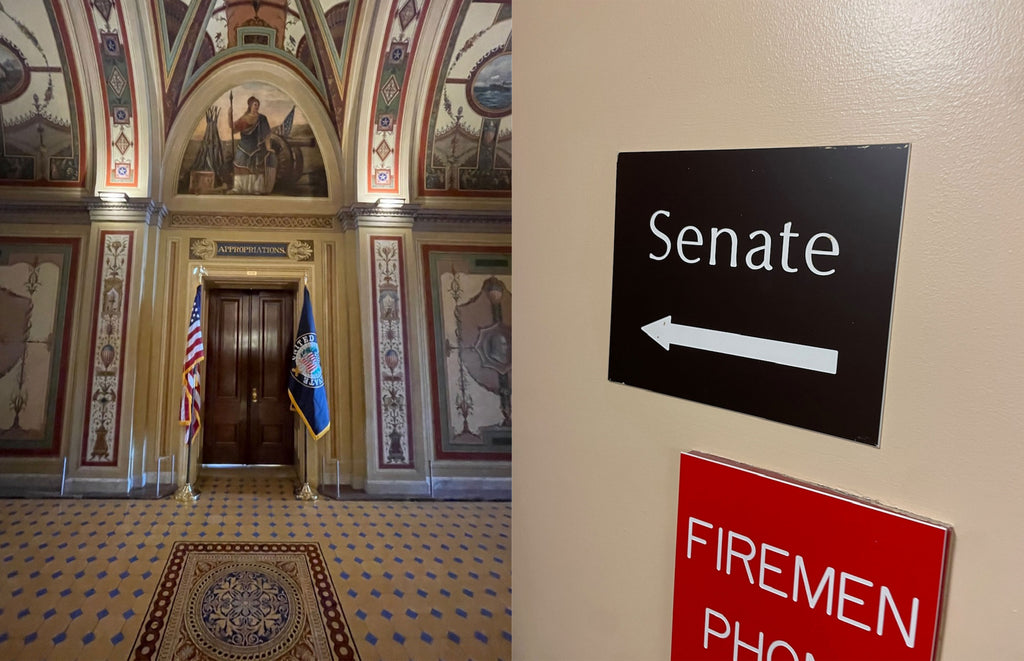
While wholly unimportant to most, the recent Senate hiccup regarding its dress code - or lack thereof - was front page for us at CMMP. I traveled to Congress from our Georgetown Showroom to set up at DRYY who have the exclusive dry cleaning within the House and Senate. Being on the Hill during these interesting times gave me an unique opportunity to reflect on the Senate’s sartorial snafu. I came away understanding that this is an important inflection point to think about re-establishing an intentional standard for one’s own image. If not for their own sake, for the sake of others.
How far we have fallen…
For a few days we had reached a new national low in Washington as the US Senate abandoned unspoken rules about how to dress on the Senate floor. There had been no formal dress code in the Senate’s history, but a tacit and a heretofore adhered to “business formal” consensus reigned since the body’s inception. When Majority Leader Democrat Chuck Schumer announced that the Senate was relaxing this requirement some cheered it as a revolt against “the establishment.” Apparently, it was a move to take John Fetterman’s health concerns into account - as well as his “everyman/working man” image of hoodies and Carhart. Republicans were quick to knock the political ping-pong ball back at the Democrats by declaring it a deplorable departure from tradition. In the end, a few days later the Senate unanimously passed an official “business formal” dress code whereby men were required to wear a jacket, collared shirt and tie on the Senate floor (although they were conspicuously quiet on what women were required to wear.)
Schumer’s original relaxing of the unwritten rules seemed to ignore both context and consensus. Indeed, a recent article in the NY Times by Rhonda Garelick made a good point that dressing is above all else contextual. She used the example that a tuxedo at a black-tie event is proper, but wearing one at a summer cookout is not. And it’s also about consensus: what do we agree makes sense for the work which we’re doing or the situation we’re in?

What is your dress code at work? Has it been completely relaxed? And what do we lose and what do we gain by ditching a business attire dress code?
In this post-Covid world, the rules of dressing for work have largely been relaxed. If for no other reason than to tempt employees back to the office. This new landscape is an opportunity for one to re-establish their image. How do you want to present yourself at work? Your image is part of your personal brand. As in any branding there are two foundational questions to answer: 1) What are you trying to say; and 2) Is it clear?
If you’re a young associate that wants to grow within the company, putting forth a competent, well-groomed, unfussy visage that shows you’ve put intention into what you look like but that the work is ultimately the most important thing is a good place to start. In practical terms, anchoring your wardrobe with an army of solid white and solid light blue shirts is a good investment. Pair these with charcoal, navy and black pants is the easiest way to dress everyday. Throw on a navy blazer or sweater and you have everything covered. These should all be fitted/tailored to your particular body type - not too tight, not too loose. Work isn’t the place to take fashion risks. I would suggest this “uniform” because everything goes together - nothing clashes. So you have ultimate utility in your wardrobe, which is smart for someone that is just starting out to middle level associate with a tight budget.
For more senior associates, or business owners, you have more leeway. But more responsibility. What kind of culture do you want at work? Jeans and graphic Ts? What does that say to your clients? Dressing has always been a dichotomy - during the week you dress up for work and the weekends you dress down. There’s a certain rhythm to that flow, which Covid certainly interrupted. And we are all out of step. But as we move slightly back to “the way things were” mentality the leaders can direct their firms and fellow workers anywhere sartorially. I humbly suggest this is a further opportunity to reverse the slide to “wearing whatever as long as you’re in the office.” Every office is different, but professionals - lawyers, finance, accountants, business people should want to distinguish themselves from college students or weekend golfers. I admittedly yearn for the 1950s Mad Men style - can’t we all just wear suits again? It was a time with less clothing decision-making and a more narrow spectrum of what to wear. Suit, tie, fedora. Monday-Friday. Everyone agrees and it works. And it looks good. Whatever your opinion on this, we are indeed at an inflection point where decisions must be made. As a business leader, what kind of office do you want to lead?
When the Senate was pressed on this very issue, I was pleased to read that it unanimously adopted its first official dress code. Business attire will be the rule on the floor: trousers, a collared shirt, jacket, and tie. Context and consensus have prevailed.
When I practiced law, I remember that putting on a suit and tie each morning made me feel more adult and professional. This uniform set the tone for the day and helped me believe that my work was important. Business attire signaled to co-workers and clients that everyone in the office was similarly committed to the work. By consensus, we conformed to the dress code. We were like any sports team that dons their shirts and shorts (or pants) before a game or match to show their commitment to winning. Without business attire in the office, we lose much of that sense of work’s purpose and meaning.
Of course, everyone likes to be “comfortable,” and traditional suiting has been anything but. Nevertheless, proper tailoring makes clothing fit and feel much better. And the advent of stretch/wool blends allows modern tailoring to perform that much better. You can have comfort and style.
Do we really want sweatpants on the Senate floor? Do you want to wear hoodies to your law firm? Or Crocs to church?
I don’t think so. Of course, I’m biased, being the owner of a custom clothing brand. But if I may, I humbly suggest we can and should dress better at work. And better in all aspects of life. Better, to me, means dressing with respect for the work, one’s image, and our colleagues and clients, friends, family and strangers.
HOME
Underlying all of the above is the idea of a varied wardrobe. One for work. One for weekends and home. It’s a philosophy that has been eroded as more people work remotely. And it makes sense - why dress “up” if you are working from your couch? Well, you probably shouldn’t. The hoodie and sweats are fine on the couch. Ah, the home. One’s castle. The place you go to relax. Well, perhaps nowadays it’s where you also work. I don’t have an opinion on how you dress for Zoom calls. It’s just your head and torso talking. But I will suggest you keep it consistent - whatever the image you want to convey know that you are indeed conveying one and to curate it carefully.
But if you’re in public - e.g., working from a coffee shop or going out to dinner- well, I implore you to think of others. Let’s get back to some sense of a responsibility to look our best - whatever you think that is.
Developing a keen sense of personal style not only elevates you, it does so for everyone you come in contact with. Back to the idea of “consensus” - if we all agree to step it up sartorially, collectively, we’ll all be better for it. We leave our homes to interact with others - we should want to be inspired by how others dress. For their style decisions. “That’s a great pair of shoes.” Or, “those sunglasses are cool, I wonder if I could pull them off?” These observations and individual contemplations as a result of seeing others are necessary in the process of developing your own image. Sure, social media and the internet allow you to see new things, but there’s nothing like sitting next to someone at dinner, or standing behind in line at a coffee shop that is much more compelling.
I want to be inspired when I go out. But that doesn’t happen enough nowadays because we have, as a society, refused to shake off the malaise of the past few years. Consider this a rallying cry to all those that care about aesthetics, good design, and style, to take some personal responsibility for the way you look. We must reinstall some pride in the act of getting dressed.
And as always, at CMMP, we’re here to help.
